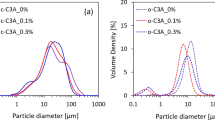Abstract
We have studied the effect of surface modification with acids and subsequent heat treatment on the properties of hydrous zirconia. It has been shown that surface modification with phosphate and sulfate groups makes it possible not only to control the phase composition of the heat-treated oxide but also to considerably suppress particle growth. We have discussed the processes involved and shown that, in the initial stages of thermolysis, the process leads to the formation of metastable, tetragonal ZrO2, which transforms into monoclinic zirconia at higher temperatures. Surface modification with phosphoric acid stabilizes tetragonal zirconia up to 850°C.
Similar content being viewed by others
References
Boldyrev, V.V., Mechanochemistry and mechanical activation of solids, Russ. Chem. Rev., 2006, vol. 75, no. 3, pp. 203–216.
Yaroslavtsev, A.B., Khimiya tverdogo tela (Solid State Chemistry), Moscow: Nauchnyi Mir, 2009.
Uvarov, N.F., Ionics of nanoheterogeneous materials, Usp. Khim., 2007, vol. 76, no. 5, pp. 454–473.
Yaroslavtsev, A.B., Ion conductivity of composite materials on the base of solid electrolytes and ionexchange membranes, Inorg. Mater., 2012, vol. 48, no. 13, pp. 1193–1209.
Yaroslavtsev, A.B. and Yampolskii, Y.P., Hybrid membranes containing inorganic nanoparticles, Mendeleev Commun., 2014, vol. 24, pp. 319–326. − XO4n
Rodgers, M.P., Shi, Zh., and Holdcroft, S., Transport properties of composite membranes containing silicon dioxide and Nafion, J. Membr. Sci., 2008, vol. 325, pp. 346–356.
Di Noto, V., Gliubizzi, R., Negro, E., Vittadello, M., and Pace, G., Hybrid inorganic–organic proton conducting membranes based on Nafion and 5 wt % of MxOy (M = Ti, Zr, Hf, Ta and W). Part I. Synthesis, properties and vibrational studies, Electrochim. Acta, 2007, vol. 53, pp. 1618–1627.
Di Noto, V., Lavina, S., Negro, E., Vittadello, M., Conti, F., Piga, M., and Pace, G., Hybrid inorganic–organic proton conducting membranes based on Nafion and 5 wt % of MxOy (M = Ti, Zr, Hf, Ta and W). Part II: Relaxation phenomena and conductivity mechanism, J. Power Sources, 2009, vol. 187, pp. 57–66.
Peighambardoust, S.J., Rowshanzamir, S., and Amjadi, M., Review of the proton exchange membranes for fuel cell applications, Int. J. Hydrogen Energy, 2010, vol. 35, pp. 9349–9384.
Ahmad, H., Kamarudin, S.K., Hasran, U.A., and Daud, W.R.W., Overview of hybrid membranes for direct-methanol fuel-cell applications, Int. J. Hydrogen Energy, 2010, vol. 35, pp. 2160–2175.
Novikova, S.A., Safronova, E.Yu., Lysova, A.A., and Yaroslavtsev, A.B., Influence of incorporated nanoparticles on ion conductivity of MF-4SC membrane, Mendeleev Commun., 2010, vol. 20, pp. 156–157.
Voropaeva, E.Yu., Stenina, I.A., and Yaroslavtsev, A.B., Ion transport in MF-4SC membranes modified with hydrous zirconia, Russ. J. Inorg. Chem., 2008, vol. 53, no. 11, pp. 1677–1680.
Pan, J., Zhang, H., Chen, W., and Pan, M., Nafion–zirconia nanocomposite membranes formed via in situ sol–gel process, Int. J. Hydrogen Energy, 2010, vol. 35, pp. 2796–2801.
Yaroslavtsev, A.B., Correlation between the properties of hybrid-ion exchange membranes and the nature and dimensions of dopant particles, Nanotechnol. Russ., 2012, vol. 7, nos. 9–10, pp. 437–451.
Yaroslavtsev, A.B., Stenina, I.A., Voropaeva, E.Yu., and Ilyina, A.A., Ion transfer in composite membranes based on MF-4SC incorporating nanoparticles of silica, zirconia, and polyaniline, Polym. Adv. Technol., 2009, vol. 20, pp. 566–570.
Shalimov, A.S., Novikova, S.A., Stenina, I.A., and Yaroslavtsev, A.B., Ion transport in MF-4SC cationexchange membranes modified with acid zirconium phosphate, Russ. J. Inorg. Chem., 2006, vol. 51, no. 5, pp. 700–705.
Yurova, P.A., Karavanova, Yu.A., and Yaroslavtsev, A.B., Diffusion properties of heterogeneous zirconia-doped membranes with the functionalized surface, Russ. J. Inorg. Chem., 2015, vol. 60, no. 11, pp. 1419–1421.
Arbizzani, C., Donnadio, A., Pica, M., Sganappa, M., Varzi, A., Casciola, M., and Mastragostino, M., Methanol permeability and performance of Nafion–zirconium phosphate composite membranes in active and passive direct methanol fuel cells, J. Power Sources, 2010, vol. 195, pp. 7751–7756.
Navarra, M.A., Abbati, C., and Scrosati, B., Properties and fuel cell performance of a Nafion-based, sulfated zirconia-added, composite membrane, J. Power Sources, 2008, vol. 183, pp. 109–113.
Stenina, I.A., Voropaeva, E.Yu., Veresov, A.G., Kapustin, G.I., and Yaroslavtsev, A.B., Effect of precipitation pH and heat treatment on the properties of hydrous zirconium dioxide, Russ. J. Inorg. Chem., 2008, vol. 53, no. 3, pp. 350–356.
Stenina, I.A., Voropaeva, E.Yu., Brueva, T.R., Sinel’nikov, A.A., Drozdova, N.A., Ievlev, V.M., and Yaroslavtsev, A.B., Heat-treatment induced evolution of the morphology and microstructure of zirconia prepared from chloride solutions during, Russ. J. Inorg. Chem., 2008, vol. 53, no. 6, pp. 842–848.
Stenina, I.A., Il’in, A.B., Kirik, S.D., Zhilyaeva, N.A., Yurkov, G.Yu., and Yaroslavtsev, A.B., Catalytic properties of composite materials based on mesoporous silica and zirconium hydrogen phosphate, Inorg. Mater., 2014, vol. 50, no. 6, pp. 586–591.
Yaroslavtsev, A.B., Proton conductivity of inorganic hydrates, Russ. Chem. Rev., 1994, vol. 63, no. 5, pp. 429–435.
Author information
Authors and Affiliations
Corresponding author
Additional information
Original Russian Text © D.V. Golubenko, P.A. Yurova, Yu.A. Karavanova, I.A. Stenina, 2017, published in Neorganicheskie Materialy, 2017, Vol. 53, No. 10, pp. 1076–1080.
Rights and permissions
About this article
Cite this article
Golubenko, D.V., Yurova, P.A., Karavanova, Y.A. et al. Surface modification of zirconia with acid groups. Inorg Mater 53, 1053–1057 (2017). https://doi.org/10.1134/S0020168517100077
Received:
Published:
Issue Date:
DOI: https://doi.org/10.1134/S0020168517100077




